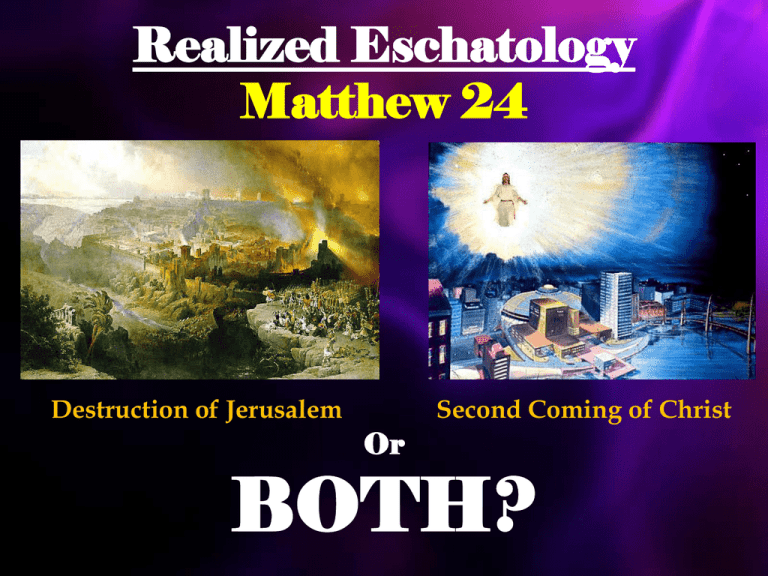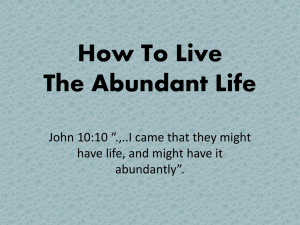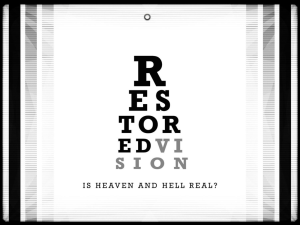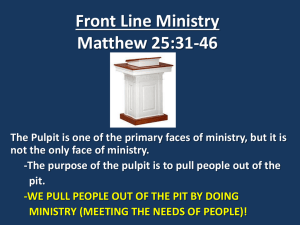serm_ppt090 - Harrodsburg Church of Christ
advertisement

Realized Eschatology Matthew 24 Destruction of Jerusalem Second Coming of Christ Or BOTH? “He who has not seen Herod’s Temple has not seen a beautiful building.” The Talmud Herod's Temple from Introduction Advocates of Realized Eschatology see ALL references to: The “last days” The “second coming of Christ” The “judgment Day” The “resurrection of the dead” The “end of the world” As already taken place at the destruction of Jerusalem in 70 A.D. The Disciples’ Questions of “….Do you not see all these things? I say to you, not one stone shall be left here upon another, that shall not be thrown down.” (Matthew 24:2) “Now as He sat on the Mount of Olives, the disciples came to Him privately, saying, "Tell us, when will these things be? And what will be the sign of Your coming, and of the end of the age?” (Matthew 24:3) The Disciples’ Questions They first asked about the fall of Jerusalem – which seemed to imply the end of the world They thought a devastation so catastrophic as to include the leveling of the Temple must mean the end of the world It only heralded the conclusion of the Jewish economy The Disciples’ Questions Temple was the pride and glory of the Jews Four to five times the size of its predecessors 20-64 A.D. in the building process Stones were 50 ft long, 20 ft wide, 16 ft thick Cut of white and green-spotted marble that would glisten in the sun “like a white mountain” Jews considered it built to last, maybe even forever! The Disciples’ Questions Jesus dashed their hopes with His few words Portrayed the coming destruction as absolute Josephus (Wars of the Jews 7, 9) “These things” in verse 3 refers to the buildings of the temple and their destruction (24:2) Verse 4 through 35, Jesus discusses the desolation and destruction of Jerusalem KEY VERSE: “But he who endures to the end shall be saved” (24:13) The Disciples’ Questions Matthew 24:4-35 Destruction of Jerusalem Jesus looked beyond the fall of Jerusalem to what would be the actual (literal) end of the world. This would be the section of scripture beginning in Matthew 24:36 and continuing through Matthew 25:46 Matthew 24:36-25:46 Second coming of Christ “This Generation” Passage Matthew 24:34 – Key passage in confirming the destruction of Jerusalem would take place in that generation “Assuredly, I say to you, this generation will by no means pass away till all these things take place.” Reference to “these things” and “this generation” is defined by its earlier use in the book of Matthew Matthew 1:17 Matthew 11:16 The “this generation” of this text is the “now” of Matthew 11:12 “This Generation” Passage “An evil and adulterous generation …. this generation …. this wicked generation” is that era, that day, the generation of Christ’s personal preaching, death, burial and resurrection. The “men of Nineveh” is the generation of Jonah. The “queen of the south” is the generation of Solomon contrasted with “this generation” of Jesus. “This Generation” Passage The “generation” of this passage is the Pharisees and Sadducees of Jesus’ day (reference “sign” in Matthew 16:1,4) “This Generation” Passage That “generation” was the time Christ was “with” them Observe that “this generation” is distinguished from “the days of your fathers” (verse 30) “This Generation” Passage “Assuredly, I say to you, this generation will by no means pass away till all these things take place. Heaven and earth will pass away, but My words will by no means pass away.” All these were to take place before the end of one generation Attempts by eschatologists to make “this generation” an end-time generation are doomed to failure on account of the context “That Day” Versus “Those Days” In describing the desolation of Jerusalem, Jesus spoke of the tribulation of “those days” Matthew 24:19, 22, 29 When discussing the judgment, he spoke of “that day and hour” Matthew 24:36, 42, 44, 50; 25:13 A sharpening of the contrast is seen “in the days that were before the flood” as opposed to “the day that Noah entered the ark.” Matthew 24:38 The “Signs” Versus “Suddenness” Jesus told of the signs preceding the destruction of Jerusalem “false Christ's and false prophets” “wars and rumors of wars” “famines and earthquakes” “all these are the beginning of sorrows” Matthew 24:6-8, 23-24 Jesus also told them of “the abomination of destruction” (Roman Army) Matthew 24:15 The “Signs” Versus “Suddenness” “So also, when you see all these things, know that it is near – at the doors!” (Matthew 24:33) They could KNOW that the destruction of Jerusalem was near But the coming of the Son of man and the consequent judgment were to be without warning Matthew 24:42-43, 50; 25:13 The “Signs” Versus “Suddenness” At least three times Jesus specifically indicated that He was giving tangible evidence of the destruction of Jerusalem Matthew 24:8, 25, 33 But the second coming and the judgment were to be sudden, unknown, as a thief strikes Matthew 24:42, 44, 50; 25:13 1 Thessalonians 5:2-4 2 Peter 3:10 Local Destruction Versus World Wide Destruction LOCAL DESTRUCTION Destruction of Jerusalem was a local event Roman army was “in the holy place” Matthew 24:6, 15 Matthew 24:15 Judean saints were to “flee to the mountains” Matthew 24:16 Local Destruction Versus World Wide Destruction LOCAL DESTRUCTION Commands to those on housetops and in the fields would have little relevance if the second coming and judgment are being considered Matthew 24:17-18 Pregnant women and mothers with infants are also unnecessary fears if the end of the world is referred to Matthew 24:19-20 Local Destruction Versus World Wide Destruction LOCAL DESTRUCTION Jesus spoke of “great tribulation, such as has not been since the beginning of the world until this time, no, nor ever shall be.” Matthew 24:21 This implies that time will continue after “this time.” There is no sense in saying “nor ever shall be” if the end of the world and the judgment already took place once and for all in 70 A.D. Local Destruction Versus World Wide Destruction LOCAL DESTRUCTION Those days evidently will “be shortened”; they will end Jesus decreed to bring the conflict to a close as soon as the general purpose was accomplished If it was the end of the world, the elect would have been saved anyway The destruction was a local event and not world wide Local Destruction Versus World Wide Destruction WORLD WIDE DESTRUCTION Second coming and judgment are universal Matthew 24:39 Flood was NOT a local event – it was world wide 2 Peter 3:6 In the destruction of Jerusalem, the saved are ordered to “FLEE” (Matthew 24:16) At the coming of the Lord, they are “TAKEN” (Matthew 24:40-41) Local Destruction Versus World Wide Destruction WORLD WIDE DESTRUCTION Matthew 25 supplements Matthew 24:36-51 Judgment of Matthew 25 involves and includes “all nations” Matthew 25:32 It is the final judgment (Matthew 25:34, 41, 46) Ten virgins parable says “be prepared,” “watch” Parable of the talents Matthew 25:21, 23, 26 compared to 24:42-51 Realized Eschatology Matthew 24 Destruction of Jerusalem Second Coming of Christ Tells us that Jerusalem was destroyed in 70 A.D. It also tells us to continue to be faithful and watch for our blessed Lord’s coming again because we do not know when He will return!









